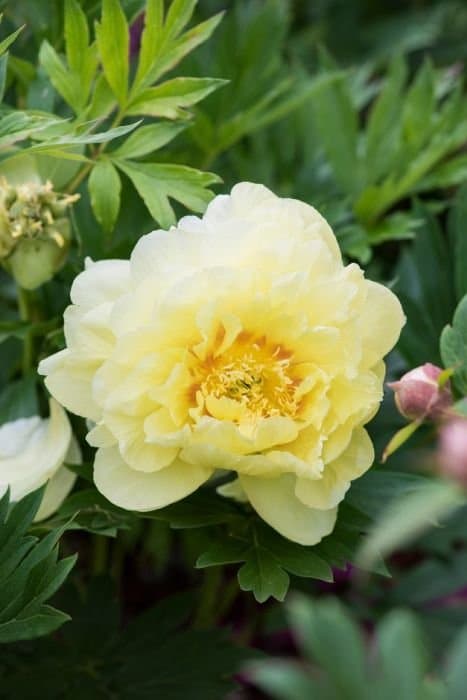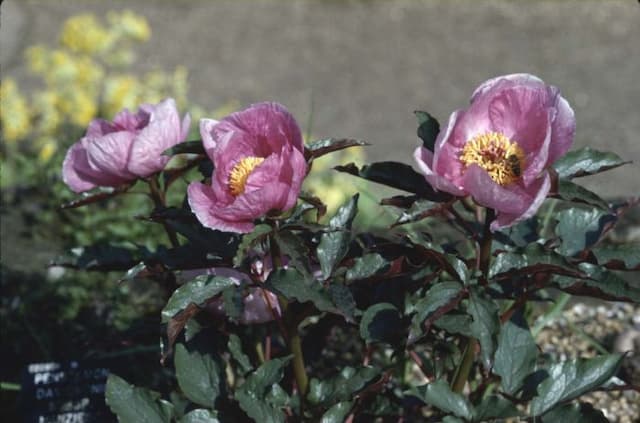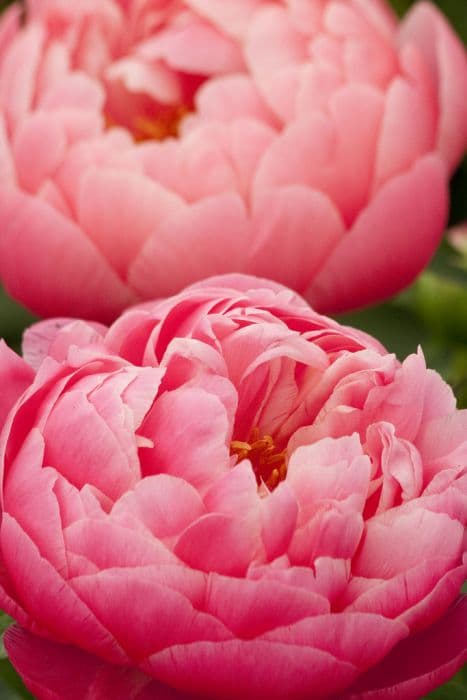Chinese Peony Paeonia lactiflora 'Amabilis'

ABOUT
The Paeonia lactiflora 'Amabilis', commonly known as the Chinese peony 'Amabilis', is a perennial plant that boasts a charming and ornamental appearance. It is characterized by its large, glossy, dark green leaves which provide a lush backdrop for its striking flowers. The blossoms of this variety are particularly eye-catching, with multiple layers of delicate, ruffled petals that form a full, rounded bloom. The petals are typically soft pink in hue, imbuing the plant with a gentle and inviting aesthetic. Although the description should omit the specific dimensions, it's often noted that the Chinese peony 'Amabilis' has a well-proportioned shape, with its blooms sitting atop sturdy stems that emerge from the foliage below. The flowers are known for their exquisite form and can often attract attention in the garden when in bloom. Additionally, the plant may produce a subtle, sweet fragrance that adds an additional layer of appeal, making it a favorite among garden enthusiasts for both its beauty and its aromatic qualities. Throughout its blooming season, the Chinese peony 'Amabilis' can create a stunning display that enriches any garden or landscape with its classic elegance and charm. The plant's overall appearance is that of grace and timelessness, often evoking a sense of nostalgia for traditional, romantic gardens of the past.
About this plant
 Names
NamesFamily
Paeoniaceae.
Synonyms
Chinese Peony, White Peony, Common Garden Peony.
Common names
Paeonia albiflora 'Amabilis', Paeonia edulis Salisb.
 Toxicity
ToxicityTo humans
The plant commonly known as the Chinese peony generally is considered non-toxic to humans. However, like many plants, it may cause mild stomach upset if ingested in large quantities. It is important to note that some people may have sensitive reactions to plants, and it is always best to avoid ingesting parts of ornamental plants due to potential individual allergies and irritations.
To pets
The Chinese peony is also generally considered non-toxic to pets such as dogs and cats. While it is not known to be a common cause of poisoning, ingestion of plant material can sometimes result in gastrointestinal upset in pets, as with humans. If a pet ingests a large amount of this plant and shows signs of illness, it is advisable to contact a veterinarian. Symptoms might include vomiting, diarrhea, and lethargy, although these are not specifically linked to peony ingestion and could be indicative of other issues.
 Characteristics
CharacteristicsLife cycle
Perennials
Foliage type
Deciduous
Color of leaves
Green
Flower color
Pink
Height
2-3 feet (60-91 cm)
Spread
2-3 feet (60-91 cm)
Plant type
Herb
Hardiness zones
3-8
Native area
China
Benefits
 General Benefits
General Benefits- Aesthetic Appeal: Paeonia lactiflora 'Amabilis', commonly known as Chinese peony, adds beauty to gardens with its large, fragrant blooms that come in shades of pink and white.
- Long Bloom Season: Chinese peonies have a relatively long flowering season, which can last up to several weeks in late spring to early summer.
- Attracts Pollinators: The flowers can attract bees and butterflies to the garden, which are beneficial for pollination of plants and the overall health of the garden ecosystem.
- Cut Flower Use: The blooms make excellent cut flowers and are popular in floral arrangements due to their size, fragrance, and striking appearance.
- Cultural Significance: Chinese peony is often associated with romance and prosperity, and is commonly used in celebratory occasions such as weddings in many cultures.
- Drought Tolerance: Once established, these peonies are relatively drought-tolerant, making them suitable for gardens in drier climates or for gardeners looking to conserve water.
- Low Maintenance: They require minimal care once they are settled in the right spot, making them ideal for gardeners of all skill levels.
- Cold Resistant: Peonies are hardy plants that can withstand cold temperatures, suitable for growing in regions with harsh winters.
- Perennial Nature: As a perennial, the Chinese peony returns year after year, providing a long-term addition to the garden without the need for replanting.
 Medical Properties
Medical Properties- Anti-inflammatory: Paeonia lactiflora 'Amabilis', commonly known as white peony, has been used in traditional Chinese medicine for its potential anti-inflammatory effects.
- Analgesic: It is believed to have pain-relieving properties that help alleviate discomfort.
- Immune system modulation: There is some evidence that white peony may influence the immune system, possibly by enhancing or suppressing certain immune functions.
- Antispasmodic: The plant may have antispasmodic capabilities, helping to relieve muscle spasms and cramps.
- Liver protection: White peony is sometimes used in herbal formulations aimed at protecting the liver and improving liver function.
- Gynecological uses: It has been used to address menstrual disorders and associated symptoms in women.
- Antioxidant: It may possess antioxidant properties, which could help in preventing oxidative stress and related damage at a cellular level.
- Cardiovascular health: There is some traditional use of white peony in promoting cardiovascular health, though clinical evidence is needed to support this application.
 Air-purifying Qualities
Air-purifying QualitiesThis plant is not specifically known for air purifying qualities.
 Other Uses
Other Uses- As a natural fabric dye: Paeonia lactiflora 'Amabilis', commonly known as Chinese peony, can be used to create a natural dye for fabrics, imparting subtle hues to textiles.
- In perfumery: The fragrant blooms of the Chinese peony are sometimes used in making perfumes and scented oils, adding their lush aroma to fragrance blends.
- As a flavoring agent: The petals of Chinese peony can infuse drinks and desserts with a mild, sweet flavor when used as an edible garnish or ingredient in culinary preparations.
- In bookbinding: The sturdy petals of the Chinese peony can be pressed and incorporated into handmade paper or used as decorative elements in the art of bookbinding.
- For photography: With their striking appearance, Chinese peony flowers are often chosen as subjects for botanical photography and art, providing inspiration and a touch of natural beauty.
- In garden therapy: Due to their beauty and growth habit, Chinese peonies can be used in therapeutic garden settings to promote relaxation and well-being.
- As part of floral art: Chinese peony blooms are a popular choice for ikebana, the Japanese art of flower arrangement, due to their form and symbolic significance.
- In potpourri: Dried petals of the Chinese peony can be added to potpourri mixes for a pleasing scent and to retain a floral aesthetic in home decor.
- For educational purposes: The plant is used in horticulture and botany classes to teach students about plant morphology and breeding due to its distinctive characteristics.
- As a natural ink: Crushed petals of the Chinese peony can be used to make a delicate, natural ink for arts and crafts, providing a unique, artistic medium.
Interesting Facts
 Feng Shui
Feng ShuiThe peony is often used in Feng Shui to promote love and romance, and to attract positive chi or energy. It can be planted in the southwest corner of a garden or displayed in the southwest corner of a room or home to enhance the relationship and love sector. Its lush blooms are especially favored for adding beauty and a sense of blooming prosperity to space.
 Zodiac Sign Compitability
Zodiac Sign CompitabilityThe peony is not used in astrology practice.
 Plant Symbolism
Plant Symbolism- Romance: Paeonia lactiflora 'Amabilis', commonly known as the peony, is often associated with romance and romantic encounters, celebrated for its lush, full blooms that embody love's richness.
- Prosperity: The peony symbolizes wealth and honor, making it a popular floral emblem in cultures that view the flower's opulence as indicative of a prosperous life.
- Beauty: With its attractive and voluptuous petals, the peony represents the ideal of beauty in various traditions, often associated with a high standard of aesthetic appeal.
- Gentleness: Despite its lavish appearance, the peony also conveys a message of gentleness and is thought to represent the virtue of softness and compassion.
- Happiness: The joyous and abundant look of the peony bloom signifies happiness and is frequently used in joyful celebrations and special occasions as a harbinger of good cheer.
 Water
WaterGarden peonies, including Paeonia lactiflora 'Amabilis', should be watered deeply once a week, with approximately 1 inch of water. The method of watering should be at the base of the plant, avoiding wetting the foliage to prevent fungal diseases. During particularly hot or dry spells, watering may need to be increased to twice a week. Adjust the watering schedule based on rainfall, and reduce watering as the plant approaches dormancy in the fall. It's important to provide enough water to soak the soil to a depth of 6 to 8 inches, which may be approximately 0.5 to 0.75 gallons depending on soil type and weather conditions.
 Light
LightGarden peonies such as Paeonia lactiflora 'Amabilis' thrive best in full sun conditions, receiving at least six hours of direct sunlight each day. They can tolerate partial shade, but too much shade can lead to weak stems and fewer blooms. The ideal spot for planting is an area with ample morning sunlight and protection from the intense heat of late afternoon sun, particularly in hotter climates.
 Temperature
TemperatureGarden peonies like Paeonia lactiflora 'Amabilis' prefer temperate climates with cold winters, as they need a chilling period to bloom. They can tolerate temperatures down to about -20°F and up to 100°F but prefer to grow in an environment where the temperature ranges between 65°F and 75°F during their growing season. The cold period should not be interrupted by warm spells as this can affect flower development.
 Pruning
PruningGarden peonies such as Paeonia lactiflora 'Amabilis' should be pruned back to the ground in the fall after the leaves have died back, which helps prevent disease and prepares the plant for dormancy. In the spring, any dead or damaged wood should be pruned to encourage healthy growth and airflow. Pruning is also a good opportunity to shape the plant and remove weak stems that may not support the heavy flowers.
 Cleaning
CleaningAs needed
 Soil
SoilThe best soil mix for Peony 'Amabilis' is well-drained, fertile loamy soil with a pH of 6.5 to 7.0. Incorporate organic matter such as compost or well-rotted manure to enrich the soil.
 Repotting
RepottingPeony 'Amabilis' is a perennial and typically does not need to be repotted as it is usually grown in the ground. Plant division every few years can rejuvenate clumps.
 Humidity & Misting
Humidity & MistingPeony 'Amabilis' tolerates the average outdoor humidity in its growing range but does not require specific humidity levels.
 Suitable locations
Suitable locationsIndoor
Peonies like 'Amabilis' are not ideal for indoor growth.
Outdoor
Plant in full sun, enriched, well-drained soil, water and mulch.
Hardiness zone
3-8 USDA.
 Life cycle
Life cyclePaeonia lactiflora 'Amabilis', commonly known as Chinese Peony, begins its life cycle as a dormant tuber, which sprouts in early spring, developing into a bushy clump of glossy, deep green foliage. The plant progresses to its flowering stage in late spring to early summer, producing large, fragrant flowers that can range from white to pink depending on the cultivar. After blooming, the plant sets seed pods if pollination has occurred, which mature over the summer and then release seeds once they dry out. Following seed dispersal or the end of the flowering period, the above-ground vegetation begins to yellow and die back as the plant enters a period of dormancy in late fall. During winter, the plant remains dormant underground, with the tuber's stored energy to be used for the next growth cycle. In its perennial life cycle, this process repeats annually, with each tuber gaining size and potentially dividing to give rise to new plants.
 Propogation
PropogationPropogation time
Early spring
The most popular method of propagating the common peony (Paeonia lactiflora 'Amabilis') is through root division, which is best done in the fall after the plants have gone dormant. To propagate by division, carefully dig up the peony plant, taking care to keep the root ball intact. Wash the soil off the roots so you can clearly see the individual tubers. Using a sharp knife, cut the root ball into sections, making sure that each section has at least 3-5 eyes, which are the growth points where new shoots will emerge. Replant the divisions promptly, placing them such that the eyes are about 1.5 to 2 inches deep (3.8 to 5 cm) in well-draining soil. It is important to avoid planting too deeply as this can prevent the peony from blooming. Water the newly planted divisions thoroughly to settle the soil around the roots.









